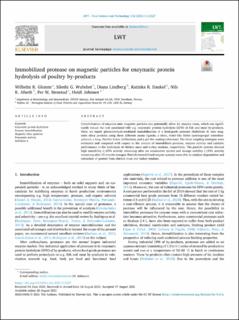| dc.contributor.author | Glomm, Wilhelm | |
| dc.contributor.author | Wubshet, Sileshi Gizachew | |
| dc.contributor.author | Lindberg, Diana | |
| dc.contributor.author | Dankel, Katinka R. | |
| dc.contributor.author | Afseth, Nils Kristian | |
| dc.contributor.author | Stenstad, Per Martin | |
| dc.contributor.author | Johnsen, Heidi | |
| dc.date.accessioned | 2021-09-27T07:59:24Z | |
| dc.date.available | 2021-09-27T07:59:24Z | |
| dc.date.created | 2021-09-16T12:08:34Z | |
| dc.date.issued | 2021 | |
| dc.identifier.citation | Lebensmittel-Wissenschaft + Technologie. 2021, 152 1-11. | |
| dc.identifier.issn | 0023-6438 | |
| dc.identifier.uri | https://hdl.handle.net/11250/2783613 | |
| dc.description.abstract | Immobilization of enzymes onto magnetic particles can potentially allow for enzyme reuse, which can significantly reduce the cost associated with e.g. enzymatic protein hydrolysis (EPH) of fish and meat by-products. Here, we report glutaraldehyde-mediated immobilization of a food-grade protease (Subtilisin A) onto magnetic silica particles using three different amine ligands; a short, brush-like linker (aminopropyl trimethoxysilane), a long, flexible linker (Jeffamine), and a gel-like coating (chitosan). The three coupling strategies were evaluated and compared with respect to the amount of immobilized protease, enzyme activity and catalytic performance in the hydrolysis of chicken meat and turkey tendons, respectively. The particle systems showed high reusability (≤85% activity remaining after six consecutive cycles) and storage stability (≤93% activity remaining after 25 months storage). Particle-immobilized enzyme systems were able to catalyze degradation and extraction of protein from chicken meat and turkey tendons. | |
| dc.language.iso | eng | |
| dc.subject | Enzymatic activity | |
| dc.subject | Enzymatic activity | |
| dc.subject | Enzymatic protein hydrolysis | |
| dc.subject | Enzymatic protein hydrolysis | |
| dc.subject | Magnetic silica particles | |
| dc.subject | Magnetic silica particles | |
| dc.subject | Enzyme immobilization | |
| dc.subject | Enzyme immobilization | |
| dc.title | Immobilized protease on magnetic particles for enzymatic protein hydrolysis of poultry by-products | |
| dc.type | Peer reviewed | |
| dc.type | Journal article | |
| dc.description.version | publishedVersion | |
| dc.source.pagenumber | 1-11 | |
| dc.source.volume | 152 | |
| dc.source.journal | Lebensmittel-Wissenschaft + Technologie | |
| dc.identifier.doi | 10.1016/j.lwt.2021.112327 | |
| dc.identifier.cristin | 1934867 | |
| dc.relation.project | Norges forskningsråd: 314111 | |
| dc.relation.project | Nofima AS: 12336 | |
| dc.relation.project | Nofima AS: 202102 | |
| dc.relation.project | Norges forskningsråd: 280709 | |
| cristin.ispublished | true | |
| cristin.fulltext | original | |
| cristin.qualitycode | 1 | |
